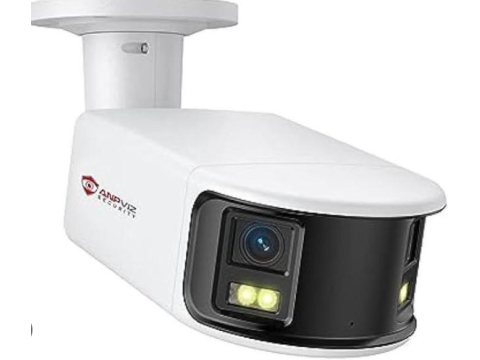Wide-Angle Security Cameras: Pros and Cons
Wide-angle security cameras are designed to monitor large areas with a single device. They are especially appealing for outdoor surveillance, but their use comes with certain limitations that need consideration.
Key Limitations of Wide-Angle Cameras
Uneven Illumination:
- The brightness may vary significantly between the center and the edges of the frame.
- This issue is particularly problematic in low-light conditions.
Reduced Resolution:
- Resolution decreases toward the edges of the frame, which can affect the clarity of objects outside the center.
Distortion:
- Wide-angle lenses often produce barrel distortion, where objects near the edges appear smaller and stretched.
- This effect can distort perspectives, complicating the analysis of the footage.
Application Scenarios
Panoramic Surveillance:
- Ideal for locations requiring broad coverage, such as airports, train stations, and shopping malls.
- Panoramic views allow tracking of individuals across large spaces.
Entry Monitoring:
- Used for smaller areas like doorways or corridors, often as video door viewers or peephole cameras.
Implementation Options
1. Using Multiple Cameras
- Position several cameras with overlapping fields of view.
- Combine the feeds to create a seamless panoramic image.
- Allows higher resolution and better coverage of key zones.
2. Panoramic Cameras
- Combine multiple lenses into a single unit with onboard image processing.
- These cameras offer an integrated panoramic view without the need for multiple devices.
Tips for Optimal Use
Understand the Viewing Angle:
- Wide-angle lenses typically have focal lengths between 1.8mm and 2mm.
- These lenses are excellent for short distances but may lack detail at greater ranges.
Consider Image Distortion:
- Test cameras in real-world conditions to determine if distortion will impact your surveillance objectives.
Match Camera Placement to Objectives:
- Use wide-angle cameras for general monitoring and complement them with standard cameras for areas requiring detail.
Evaluate Lighting Conditions:
- Ensure adequate and uniform lighting to mitigate uneven illumination issues.
Conclusion
Wide-angle security cameras are invaluable for monitoring expansive areas with minimal equipment. However, their limitations in detail and distortion effects must be carefully considered. For areas requiring high detail or extended distances, a combination of standard and wide-angle cameras often provides the best solution.
Surveillance Camera Viewing Angle
11/01/2025
Panoramic Security Cameras
11/01/2025

